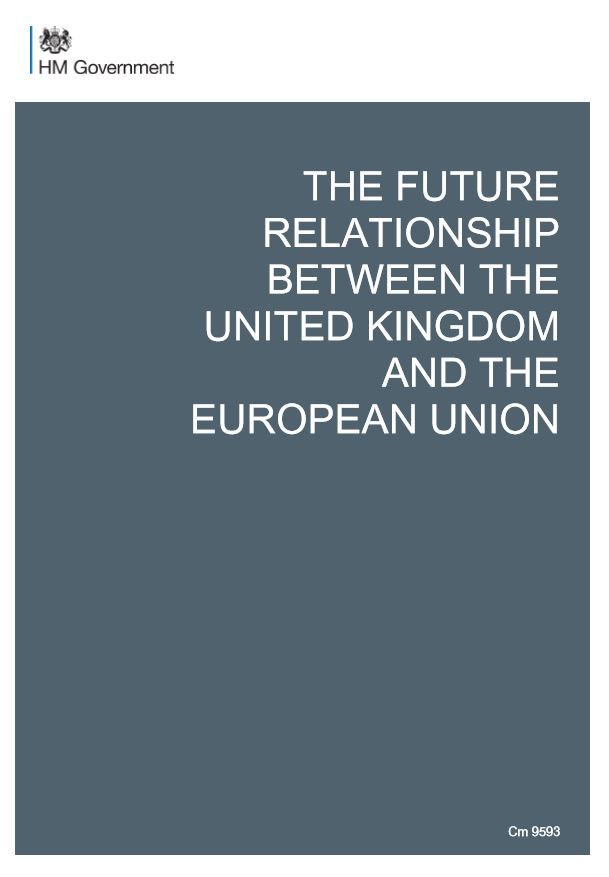By Mike Josypenko MIEx, IOE&IT Senior Director of Special Projects
The government's latest White Paper 'THE FUTURE RELATIONSHIP BETWEEN THE UNITED KINGDOM AND THE EUROPEAN UNION' was launched on Thursday, amid keen anticipation from businesses in the UK and the European Union. It sets out the latest UK vision for a future relationship, dealing in trade in goods and services, as well as security cooperation, immigration and general oversight mechanisms.
The paper, which had a 'difficult birth', comes almost 12 months after the publication of the government’s original position papers on trade and customs matters, and seeks to refine its proposals, in order to kickstart the Brexit negotiations.
At the heart of its trade policy is the proposal for a Free Trade Area between the UK and the EU, which would see the UK adopting a common rulebook on standards and regulations, including food and agricultural products, which would mirror those of the EU, although this would only extend to those regulations which impact on cross border movements of goods.
The paper also proposes a Facilitated Customs Agreement with the EU, which would allow goods to pass between the UK and EU Member States without the need for a formal customs clearance process and physical or documentary inspections at the border. It would also enable tariff-free trade, regardless of the origin of the goods. This is a major change from the previous 'trade agreement' based approach, which would have limited any tariff agreement to goods which were of either UK or EU origin.
The agreement would enable the UK to operate a separate tariff from the EU, setting different levels of duty. At the same time, the UK would establish a dual tariff mechanism for goods arriving into the UK from outside the EU, which would see goods which are destined for consumption within the UK being taxed at the new UK tariff rate, while goods landing in the UK, but destined eventually for the EU, would be taxed at the appropriate EU tariff level. Where the ultimate destination of goods cannot be identified, they would be taxed at the higher rate, and a reimbursement or adjustment applied if necessary.
This last measure is a rehash of a framework set out in the government’s previous paper under its “Close Customs Partnership” proposal. This initially drew criticism from business, as being too cumbersome and administratively intense. HMRC maintain that the new system would be more user friendly and less bureaucratic, although little detail is currently available. Nevertheless it is difficult to see how a procedure could work in practice in a complex manufacturing process such as food production, where it may be difficult to identify the ultimate destination of any batch of manufactured product, or even to identify the origin of any specific raw materials in a particular production batch.
The paper also proposes ambitious plans to allow cumulation of origin between UK and EU content for goods exported to countries which have a current, or future Free Trade Agreement with the UK or EU. Essentially, this would mean that both UK and EU content could be considered as local or eligible content in any preference scheme. This would be a major benefit for both UK and EU supply chains, but it is difficult to see how this could be achieved in the short term, as it would need the acceptance of each of the UK and EU’s free trade agreement partner countries.
The paper and its proposals have received generally positive feedback from business. If adopted, it could relieve many of the major concerns of UK exporters by enabling:
• Smooth unbroken transit of goods between the UK and EU borders, including the problematic Irish land border,
• Removing the need for physical and documentary examinations for goods, including food and agricultural products,
• Enabling tariff-free trade between the UK and EU, without consideration of origin,
• Allowing the UK to pursue a separate tariff to the EU, and conduct an independent trade policy, signing free trade agreements with other countries.
The picture is less clear regarding provision of services. The proposal recognises that exit from the Single Market will remove many of the benefits enjoyed by service e sectors such as the financial services industry. Instead it proposes to negotiate a series of new arrangements on a sector-by-sector basis, with the goal of securing the best outcomes possible. This perhaps echoes Switzerland’s approach to dealing with the EU. In recent years, Switzerland has negotiated more than a hundred small and specific agreements with the EU, securing specific benefits.
The initial feedback on the proposals from traders in goods has been generally positive, although noticeably less positive from the services sectors. The paper is lacking in hard detail, and it is to be hoped that practical details will be supplied in the weeks ahead by government departments such as HMRC and the Department for International Trade. The government itself recognises that the paper is a draft, which may need to be amended in the heat of negotiations.
However, the true test of the document will be the reaction of the other 27 EU states, and of the EU negotiating team. At the time of writing, little hard commentary has been made, as representatives will want to study the detail of this lengthy document. Despite the careful choice of terminology in the document (“Free Trade Area”, “Customs Agreement” instead of Customs Union), it is difficult to avoid the suggestion that the UK is trying to secure many of the benefits of the Single Market and Customs Union, while enjoying the freedom to conduct an independent trade policy. We should expect more comments about 'cherry-picking' and 'having your cake and eating it'.
Nevertheless, if the document provides enough relevant content to kickstart the negotiations in a positive direction, it has the potential to help towards a settlement which could avoid some of the worst effects of Brexit for businesses.
View the White Paper here


